This tutorial is aimed at providing you a basic understanding of your winch and the proper way of using it, with an emphasis on safety.
As every winch recovery is different, it is impossible to describe every possible scenario. But with providing you the basic techniques you will be able to understand how to operate your winch, and in the case of an assistant/buddy , know what to do when assisting during the recovery process.
The main important aspect of winching is to THINK through each situation BEFORE jumping into action. Applying a bit of common sense goes a long way and remaining calm is ESSENTIAL.
WHICH ACCESSORIES SHOULD I HAVE
Hook Strap
The Hook Strap is used to hold the hook and keep fingers away from the fairlead as the rope is being spooled in.
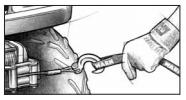
Snatch Block
The multi-purpose snatch block allows you to:
(1) increase your winch’s pulling power. A double line rope pull will halven the load on your winch.

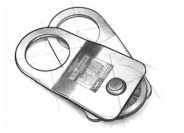
(2) change your pulling direction without damaging the rope.
Rope gloves
Having proper gloves is essential to perform winching. On a steel rope you can easily cut yourself, while with a synthetic rope there is risk of burning your hands if you hold on to the rope.
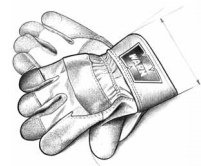
D-Shackles or Soft Shackles

Will be used to connect your winch to the object that need to be winched. If your winch has a hook, then you can use the hook directly.
WORDS OF CAUTION
-Never attach a recovery strap to the winch hook to increase the length of a pull.
-Never use kinetic straps that develop tremendous and potentially dangerous amounts of force when stretched.
-Never operate winch with less than 5 wraps of rope around the drum. Rope could come loose from the drum, as the rope attachment
to the drum is not designed to hold a load.
-STAY CLEAR FROM THE ROPE AT ALL TIMES WHEN IT IS UNDER LOAD.
STRETCHING YOUR WINCH ROPE FOR THE FIRST USE
The life of a wire rope is directly related to the use and care it receives. Tensioning the wire rope is critical to ensure a long product life. Tensioning the wire rope will prevent outer layers of wire rope from pinching and deforming the inner layers. During its first use, a new wire rope must be spooled onto its drum under a load of at least 500 lbs. (227kgs). Use the following instructions toproperly stretch the wire rope onto the
winch drum:
BEFORE YOU PULL
Practice using your winch before you get stuck. A real situation is no time to be learning how to use your winch.
Whether you’re recovering another vehicle or pulling a stump from the ground, knowing the proper winching
techniques can help keep you and others around you safe. And perhaps the most important part of the winching process,
regardless of the situation, is what you do BEFORE you pull.
1. Always take your time to assess your situation and plan your pull carefully.
2. Always take your time when using a winch.
3. Use the right equipment for your situation.
4. Always wear gloves and do not allow the rope to slide through your hands.
5. You and only you should handle the rope and operate the remote control switch.
6. Think safety at all times.
7. Practice. Practice and practice the steps.
RIGGING FOR THE PULL
The following steps describe how to recover your vehicle with rigging a single line pull. Double or multiple line rigging techniques follow the same basic steps,but use a snatch block to assist the process.
Step 1: PUT ON GLOVES.

Step 2: DISENGAGE CLUTCH.
To allow free spooling of the winch drum, rotate the clutch lever on the winch to Disengage. Freespooling conserves battery power.

Step 3: FREE THE WINCH HOOK AND ATTACH HOOK STRAP.
Free the winch hook from its anchor point. Attach hook strap to the hook (if not attached).
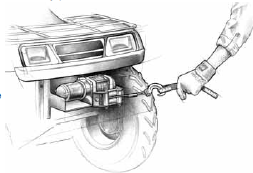
Step 4: PULL ROPE TO THE STUCK VEHICLE
Pull out enough rope. Be sure to keep certain amount of tension in the wire as it can become twisted and overwrap
when slackened, leading to rope damage. To prevent loosing the end, hold the winch hook in the hook strap while
you work.
Step 5: SECURE TO THE STUCK VEHICLE.
Use Soft Shackles or a rated D-Shackle.
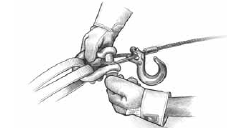
Step 6: LOCK THE CLUTCH.
Lock the winch drum by rotating the clutch lever on the winch to Engage.
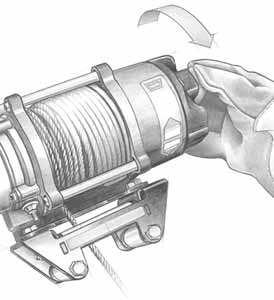
Step7 : CONNECT THE REMOTE CONTROL.
Be careful not to let the remote control cord dangle in front of the winch. Always disconnect the remote control when not in use.
Step 8: PUT ROPE UNDER TENSION.
Using the winch switch, slowly wind the rope until no slack remains. Once the rope is under tension, stand well clear, and never step over it.
Step 9: CHECK THE VEHICLE THAT WILL BE PULLED.
Communicate with the vehicle owner about your course of action, and ask him to put the vehicle in 4LO. Do a last inspection of the connection before starting the pull.
Step 10: CHECK ROPE.
The ropeshould be neatly wound around the spooling drum. Improper winding can cause damage to the rope.
Step 12: LAY SOMETHING OVER THE ROPE,
if you decide it is necessary, midway between the winch and the anchor point to absorb energy should the rope snap loose. Tree limbs, heavy
jackets, chain, back pack and the like may be used for this purpose.
Step 13: MAKE YOUR INTENTIONS CLEAR.
Be sure that everyone in the immediate vicinity surrounding the winching operation is completely aware of your intentions before you pull.
Declare where the spectators should not stand — never behind or in front of the vehicle and never near the rope or snatch block. Your situation may have other “no people” zones.
Step 14: BEGIN WINCHING.
With the winching vehicle’s engine on and light tension already on the rope, begin winching slowly and steadily. Be sure that the rope is winding evenly and tightly around the spooling drum. The vehicle may be steered while winching but not driven. Driving vehicle causes rope to become slack and entangled. It is advisable to winch in "blips" by pushing the button for 2-3 seconds, followed by a pause of 5-10 seconds. This helps to keep the winch motor cool and during this time you can keep inspecting if the rope loops well on the winch or if no damage is occuring to the stuck vehicle. The stuck vehicle can also give gently blips of throttle to help the recovery process.
During recovery of another vehicle, it is not advisable to keep the winching vehicle in (P) Park, as this causes a huge load on the transmission and might even damage the transmission. Use your handbrake, stay inside the vehicle, and keep your brake pedal pressed in hard. Use the remote to control the winching process, and have a buddy standing on a safe distance to act as a spotter. Use your radio to communicate with the stuck vehicle and your spotter.
SOME LAST HINTS:
A winch is very powerful, yet you should ALWAYS try to reduce the stress of the recovery, by deflating the stuck vehicle further down, and shoveling/creating a path where the vehicle can drive out with assistance of the winch. So make sure the wheels are free and can freely rotate.
A winch recovery should always be done straight, and not under an angle as this will severely increase the risk of damage to the rope or stuck vehicle. If you need to pull from an angle you can use a snatch block.









